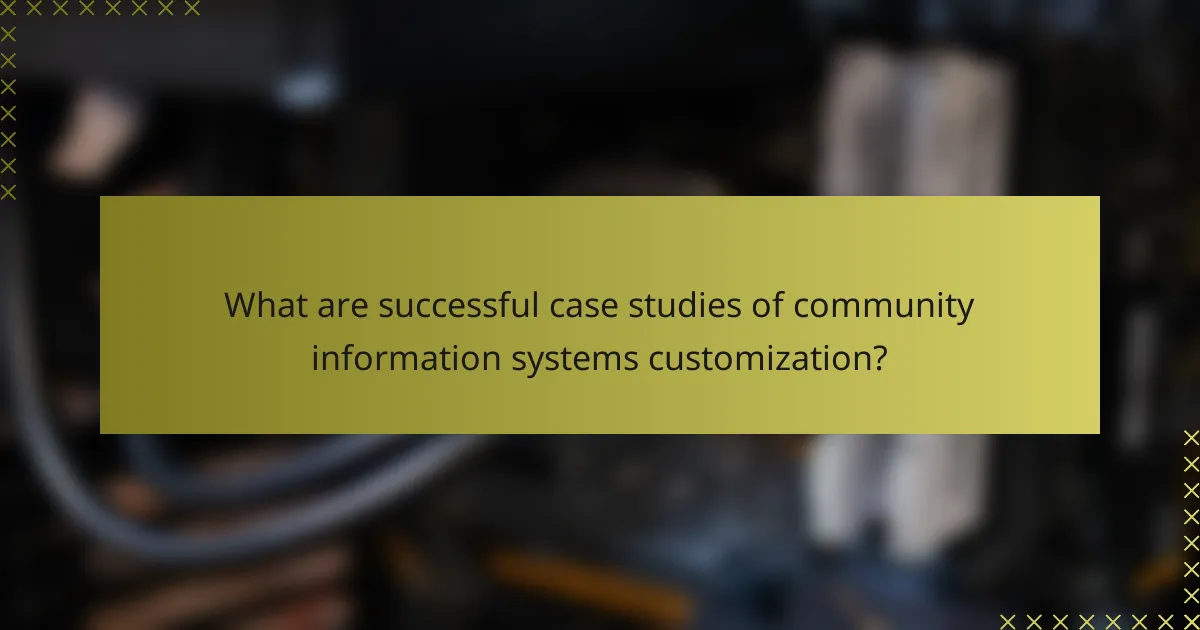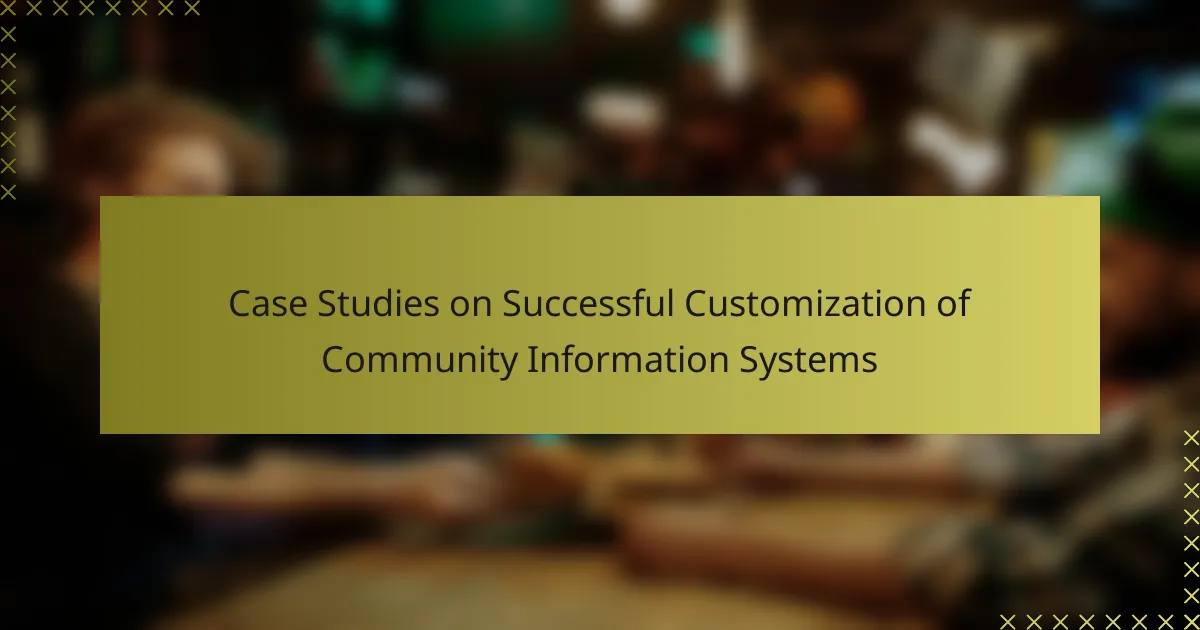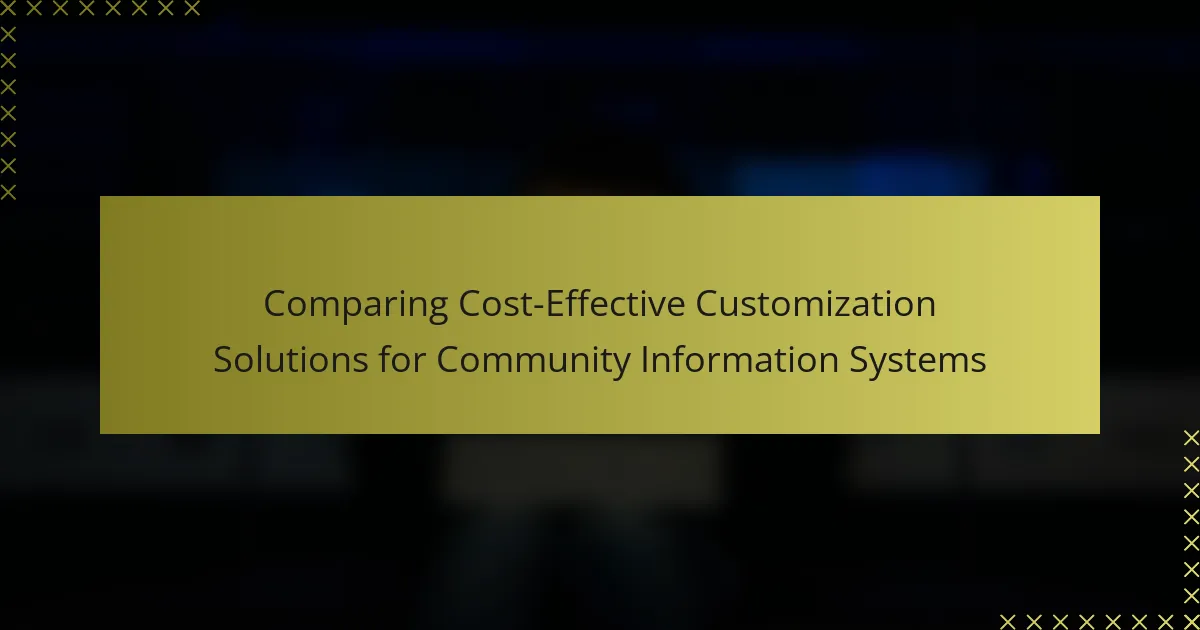Case studies on the successful customization of community information systems illustrate how local governments effectively tailor technology to address specific community needs. By focusing on user engagement and data accessibility, these systems enhance public services and foster active participation between citizens and local authorities.

What are successful case studies of community information systems customization?
Successful case studies of community information systems customization demonstrate how local governments adapt technology to meet specific community needs. These examples highlight the importance of user engagement, data accessibility, and tailored functionalities that enhance public services.
City of San Diego’s Open Data Portal
The City of San Diego’s Open Data Portal serves as a prime example of effective customization in community information systems. Launched to improve transparency, the portal provides residents with access to a wide array of datasets, including crime statistics, public health information, and environmental data.
Key considerations for this system include user-friendly navigation and robust data visualization tools. By prioritizing accessibility, the city encourages community engagement and informed decision-making, allowing citizens to explore data relevant to their interests.
Chicago’s 311 Service Request System
Chicago’s 311 Service Request System exemplifies a customized approach to citizen services. This system allows residents to report issues such as potholes, streetlight outages, and other municipal concerns via phone, web, or mobile app. The integration of multiple reporting channels enhances user experience and responsiveness.
To ensure effectiveness, the city focuses on real-time tracking of requests and transparent communication about resolution times. This system not only streamlines service delivery but also fosters accountability within city departments, making it a model for other municipalities.
New York City’s Community Board Management System
New York City’s Community Board Management System is designed to facilitate collaboration between community boards and city agencies. This customized platform allows for the management of meeting agendas, member communications, and public feedback, ensuring that local voices are heard in governance processes.
Key features include online meeting scheduling and document sharing, which enhance participation and streamline operations. By empowering community boards with effective tools, the city promotes civic engagement and responsiveness to neighborhood needs.

How did these systems improve community engagement?
Community information systems have significantly enhanced engagement by facilitating direct communication between citizens and local authorities. These systems enable residents to participate actively in governance and access information easily, fostering a more inclusive environment.
Increased citizen participation in local governance
By utilizing community information systems, local governments can encourage greater citizen involvement in decision-making processes. Features such as online surveys, forums, and feedback tools allow residents to voice their opinions and contribute to policy discussions.
For instance, municipalities that implement these systems often see participation rates increase by a notable margin, sometimes reaching over 30% in local elections or community initiatives. This engagement can lead to more representative governance and better alignment with community needs.
Enhanced transparency and accountability
Community information systems improve transparency by providing easy access to government data, budgets, and project updates. This openness helps build trust between citizens and their local governments, as residents can see how decisions are made and funds are allocated.
Moreover, accountability is reinforced when citizens can report issues or track the progress of community projects. For example, systems that allow residents to submit maintenance requests or view real-time updates on local developments can lead to quicker resolutions and a more responsive government.

What challenges were faced during customization?
Customization of community information systems often encounters significant challenges, primarily related to data integration and user adoption. Addressing these issues is crucial for ensuring the effectiveness and sustainability of the customized systems.
Data integration issues
Data integration issues arise when merging information from various sources into a single system. These challenges can include incompatible data formats, varying data quality, and differing data structures. For instance, a community information system may need to integrate data from local government databases, social services, and non-profit organizations, each with its own format and standards.
To overcome data integration challenges, it is essential to establish clear data governance policies and use standardized data formats. Employing middleware solutions can facilitate smoother data transfers and ensure consistency across platforms. Regular audits of data quality can also help identify and rectify discrepancies early in the process.
User adoption resistance
User adoption resistance is a common hurdle when implementing customized community information systems. Stakeholders may be hesitant to embrace new technologies due to concerns about usability, training requirements, or changes in workflow. For example, community workers accustomed to traditional methods may resist transitioning to a digital platform.
To mitigate user resistance, it is vital to involve end-users in the customization process from the outset. Gathering feedback through surveys or focus groups can help tailor the system to their needs. Providing comprehensive training and ongoing support can also ease the transition, fostering a sense of ownership and confidence in using the new system.

What best practices emerged from these case studies?
Best practices from successful customization of community information systems highlight the importance of stakeholder involvement and iterative testing. Engaging users throughout the design process and refining systems based on feedback leads to more effective and user-friendly solutions.
Stakeholder involvement in design
Involving stakeholders in the design phase ensures that the system meets the actual needs of the community. This can include community members, local organizations, and government representatives who provide insights into specific requirements and preferences.
Effective methods for stakeholder engagement include workshops, surveys, and focus groups. For instance, a community information system in a European city successfully integrated feedback from local residents, resulting in features that directly addressed their concerns, such as accessibility and language options.
Iterative testing and feedback loops
Iterative testing and feedback loops are critical for refining community information systems. By continuously testing prototypes and gathering user feedback, developers can identify issues and make necessary adjustments before full deployment.
A practical approach is to implement pilot programs that allow a small group of users to interact with the system. This method helps in uncovering usability problems and gathering actionable insights, which can lead to enhancements that improve overall user satisfaction and system effectiveness.

How can municipalities choose the right customization approach?
Municipalities can choose the right customization approach by thoroughly understanding their community’s unique needs and evaluating the compatibility of available technologies. This process involves assessing priorities, stakeholder input, and the technical landscape to ensure effective implementation.
Assessing community needs and priorities
Understanding community needs is crucial for effective customization of information systems. Municipalities should engage with residents through surveys, focus groups, and public meetings to gather insights on their priorities, such as accessibility, user-friendliness, and specific service requirements.
Once needs are identified, municipalities can prioritize them based on factors like urgency, impact, and available resources. A simple ranking system can help in deciding which features to implement first, ensuring that the most critical needs are addressed promptly.
Evaluating technology compatibility
Evaluating technology compatibility involves assessing existing systems and determining how new customizations will integrate with them. Municipalities should consider factors such as software interoperability, hardware requirements, and data management capabilities to avoid costly disruptions.
It’s also essential to review vendor support and community feedback on various technologies. Municipalities can create a comparison table of potential solutions, highlighting strengths and weaknesses, to facilitate informed decision-making. This approach helps ensure that the chosen technology aligns with community needs and enhances overall system functionality.

What are the costs associated with customizing community information systems?
Customizing community information systems involves various costs that can significantly impact budgets. These costs typically include initial development and implementation expenses, as well as ongoing maintenance and support fees.
Initial development and implementation costs
The initial development and implementation costs for customizing community information systems can vary widely based on the complexity of the system and the specific needs of the community. Generally, these costs can range from a few thousand to several hundred thousand dollars.
Key factors influencing these costs include the choice of technology, the level of customization required, and the expertise of the development team. For example, opting for open-source solutions may reduce initial costs, while bespoke software development may lead to higher expenses.
Ongoing maintenance and support expenses
Ongoing maintenance and support expenses are essential to ensure the community information system remains functional and up-to-date. These costs typically account for a percentage of the initial development costs, often ranging from 15% to 20% annually.
Communities should budget for regular updates, security patches, and user support. It’s crucial to establish a clear maintenance plan that outlines responsibilities and expected service levels to avoid unexpected expenses and ensure system reliability.

What are the future trends in community information systems?
Future trends in community information systems focus on enhanced user engagement, data integration, and the use of advanced technologies. These systems are evolving to better meet the needs of communities through personalized experiences and improved data analytics.
Integration of AI for data analysis
Integrating AI into community information systems significantly enhances data analysis capabilities. AI can process large datasets quickly, identifying patterns and trends that may not be visible through traditional methods. This allows communities to make informed decisions based on real-time insights.
When implementing AI, consider the types of data you have and the specific outcomes you want to achieve. For example, using machine learning algorithms can help predict community needs or optimize resource allocation. However, ensure that data privacy regulations are adhered to, particularly in regions with strict data protection laws.
To effectively integrate AI, start with a clear strategy. Identify key performance indicators (KPIs) that matter to your community, and choose AI tools that align with these goals. Regularly evaluate the effectiveness of AI applications to ensure they meet evolving community needs and adjust as necessary.



